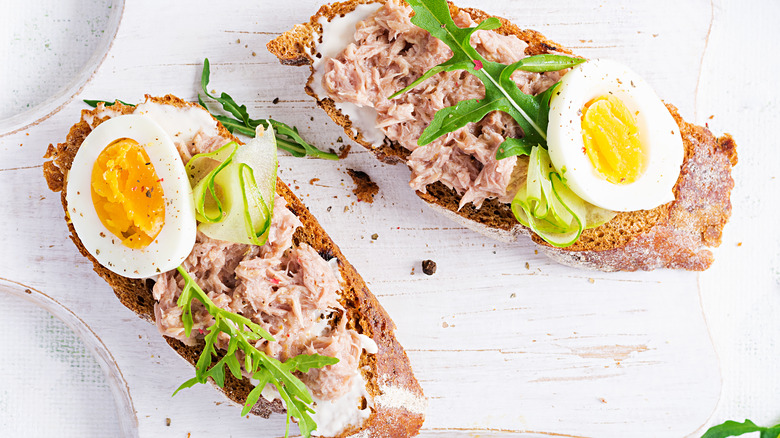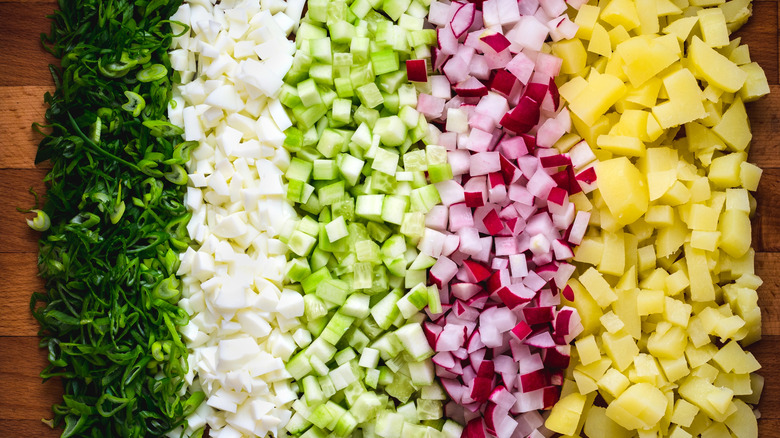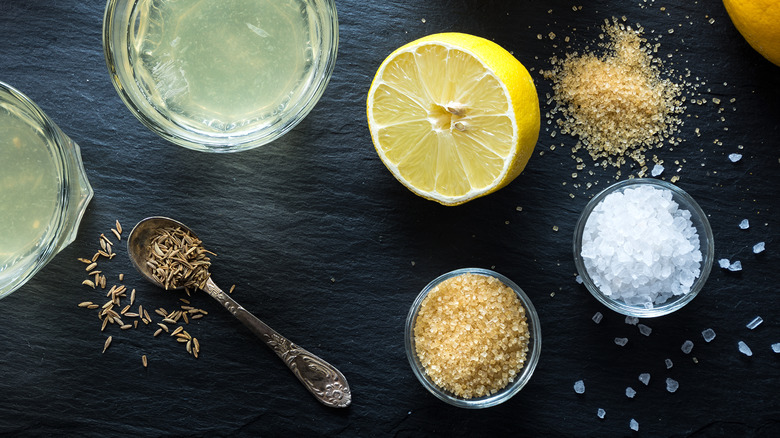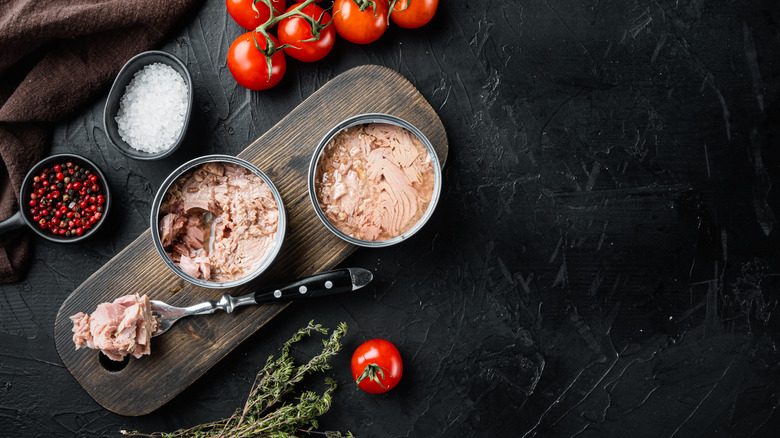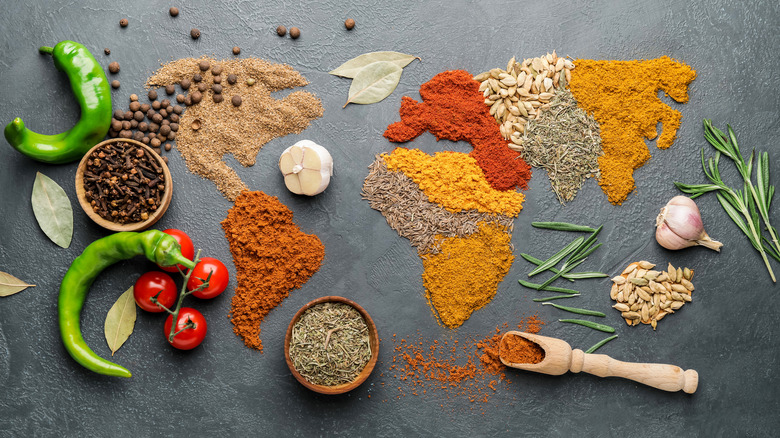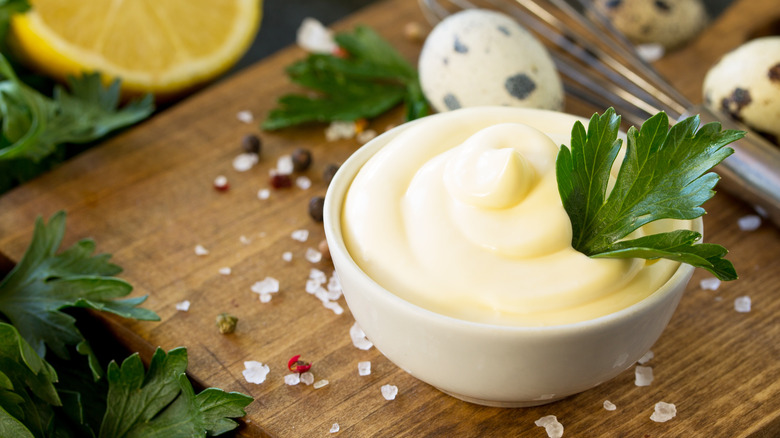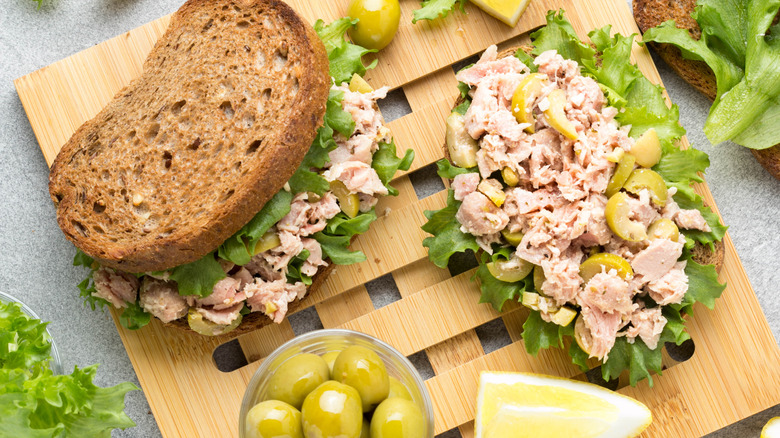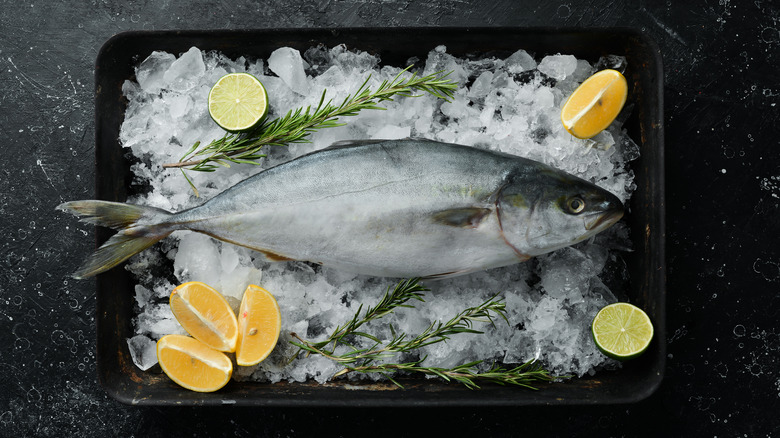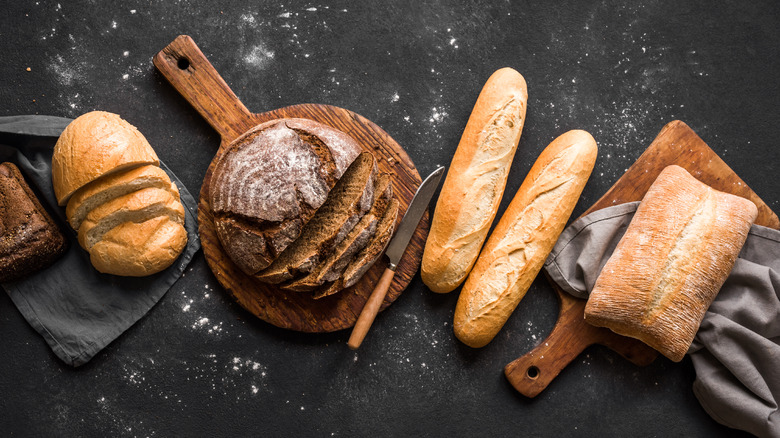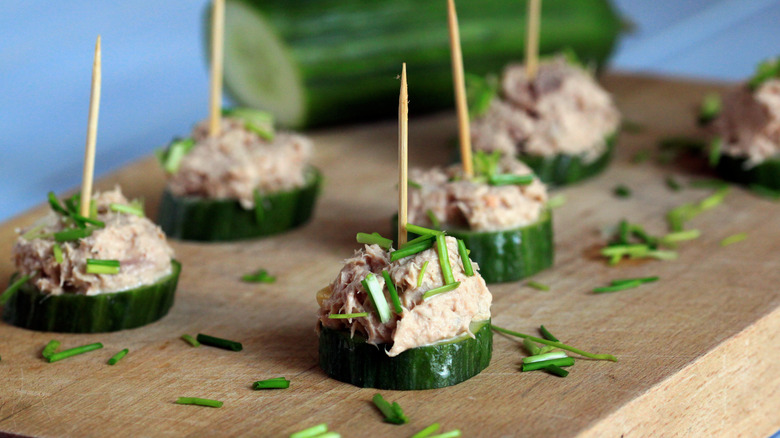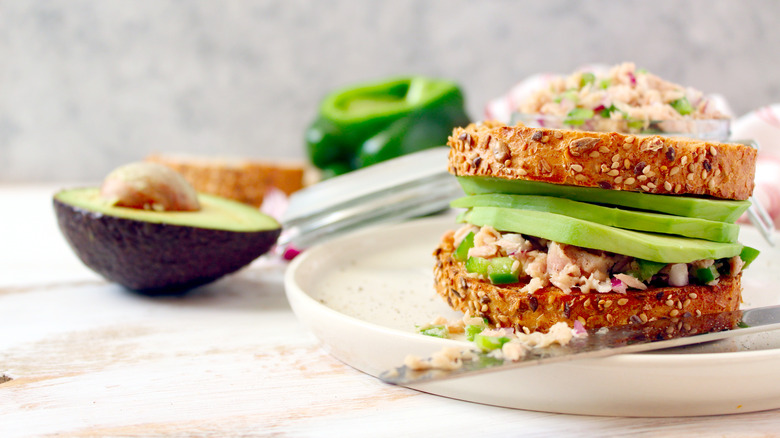10 Big Mistakes Everyone Makes With Tuna Salad
According to the National Fishery Institute, one billion pounds of tuna are eaten every year in the United States only, with one go-to recipe being tuna salad, the ubiquitous salad and sandwich add-on that has been commonplace since the 1930s. Tuna quickly went from being animal feed and fish bait to becoming an ingredient used in humble to-go sandwiches and gourmet restaurant specials alike. One reason for this change in public perception is the strongly documented benefits of including tuna as part of a balanced diet.
According to Lifehack, consuming tuna on a weekly basis can improve heart health, support weight loss efforts, reduce the risk of cancer, and improve eye health. Not bad for something you can buy for under $5 a can! And on top of being good for you, tuna salad can be done in mere minutes, squashing the idea that eating healthy is time-consuming, and making it a perfect lunchtime staple.
But not all tuna salads are created equally, and if, like a lot of people, you have been making one of the big mistakes below, now is the time to upgrade your lunches for a truly spectacular tuna salad you will want to make over and over again.
Mistake #1: Not chopping the vegetables finely enough
Unless you're going for a chunky twist on tuna salad, roughly chopped pieces of celery and onion are not only unsightly, they also detract from the overall flavor of your tuna salad. In fact, according to chef Bill Fuller for NPR's Food for Thought section, "Flavor is the taste of what is in your mouth, but it is also partly textural." By chopping all the vegetables finely enough, each mouthful will be perfectly balanced, for a smooth ride from the first bite to the last.
If you are unsure of which vegetables to use, start with the commonly used celery stalks, adding in onions (regular white onion, green onions, and shallots are all good choices), and finishing off with extras of your choosing like pickles and capers. Just be sure to sharpen your knife, take your time, and chop those veggies as fine as you can. As you get more comfortable with your base recipe, you can experiment with different ingredients.
Mistake #2: Forgetting to balance out the flavors
So much about cooking is balancing out flavors, and this is true even if you are making a quick salad for an on-the-go lunch. Being short on time is no excuse for being short on flavor! In general, acidic ingredients were never a strange addition to fish dishes, from thin slices of lemon on top of broiled Alaskan cod to vinegar in Middle Eastern fish sauces. In fact, you might find that a little fresh lemon juice is just what you need to make the flavors in otherwise plain canned tuna really pop. Try adding a squeeze of lemon to your tuna salad, or even a little grated lemon zest. Be sure to mix it in thoroughly.
Sugar might be a more surprising addition, but it was recommended by Cook's Country as being a secret ingredient you won't be able to skip once you try it. This makes sense since sweet pickles and their juices are often added to tuna salad recipes. They recommend half a teaspoon of sugar per can, which might be a little too much for some, but this is where you can have fun experimenting. Start with less, or substitute the brine from a jar of bread and butter sweet pickles, for example.
Mistake #3: Using water-packed tuna instead of oil-packed
Steve Cook, head of the highly regarded Rooster deli and Zahav fine-dining establishment in Philadelphia, recommends against using water-packed tuna, as it will inevitably lead to a dry tuna salad sandwich. His trick for enhancing the mouthfeel of canned tuna is to mix in another oily fish, sardines. Unlike tuna, sardines are low on the food chain and lower in mercury. They are also more affordable, more sustainable, and can add a boost of flavor you might otherwise miss.
Beyond selecting oil-packed tuna, be sure to also look for the "pole and line caught" label, which is more sustainable and lowers the risk of other, sometimes endangered fish from being caught at the same time. The team at Bon Appetit recommends the brands Genova, Tonnino, Bela, and Ortiz. And if you feel like investing a little (or a lot) more into your tuna salad, try Serious Eats Senior Culinary Advisor Daniel Gritzer's recommendation and try a cut of the tuna's fattier belly called ventresca.
Mistake #4: Not adding flavorful add-ons like spices, herbs, and salt
Famed food blogger and Silicon Valley guru Jonathan Hirshon of The Food Dictator shares his secret add-on for a truly spectacular tuna salad ... Schmaltz, also known as rendered chicken fat, which will add a discrete richness to the mayonnaise. If you are not feeling that adventurous (yet!) and are looking for more conservative add-ons, he also recommends "a hint of curry powder, which (...) really amps up the flavor quotient in a truly delicious way." No matter what added flavors you select, do not forget to at least add salt.
As for herbs, you can give the classic finely chopped parsley a try, basil, chives, tarragon like in Rachael Ray's Lemon Tuna Salad, or Emeril Lagasse Baby Bam spice mix which he uses in his Simply Sensational Tuna Salad and which calls for oregano, basil, thyme, and parsley. But before adding all those in, pick a couple to try, adding more as you see fit. One rule of cooking is that you can always add more salt and flavorings, but you can't always take them out.
Mistake #5: Using cheap mayonnaise or low-quality substitutes
What do Ina Garten, Rachael Ray, Jaime Oliver, Emeril Lagasse, and Bobby Flay have in common (besides serious Food Network star cred)? None of them use mayonnaise substitutes like Miracle Whip, which according to HealthLine was developed as a cheap mayo alternative. In its simplest form, mayonnaise is made simply of egg yolks, oil, and an acid such as lemon juice or vinegar, and those are the clean flavors you want in your tuna salad.
If you don't like mayo, or are looking to change things up a little for variety, you can use mashed avocado as a substitute, or even yogurt like on Jamie Oliver's Hot Tuna Salad. Or hone your culinary skills and try to make your own mayonnaise a home. It is not as hard as people think, but remember that it has a much shorter shelf life than store-bought mayonnaise which has been pasteurized.
Mistake #6: Not fully draining the can of tuna
No one wants tuna salad that drips everywhere as you eat it, or soaks into the bread leaving you with a soggy sandwich. Be sure to fully drain the can of tuna before mixing in the other ingredients. That being said, if your tuna salad still ends up watery, don't toss it out, and don't panic. You can still save it. The Cooking Bar recommends either adding more tuna (fully drained this time!) or mixing in a little hard-boiled egg, until you get your preferred consistency. Some like to heat the tuna in a pan for a while to let the water evaporate, or add in Panko breadcrumbs for both crunch and a drier texture.
As with all cooking experiments, it might take you a few tries to find the perfect consistency, but that's part of the fun. One more thing to keep an eye on is the amount of mayonnaise you add. Do it progressively, as even with perfectly dry tuna, too much mayo will still give you a soggy mess.
Mistake #7: Storing it wrong - tuna salad isn't shelf stable!
Mayonnaise needs to be refrigerated, and so does tuna salad. If you are making it in advance, be sure to keep it in your fridge at all times. And if you plan on taking your sandwich on a hike or to work, adding an ice pack to your lunch bag is always a good idea. Ideally, you will want to assemble your tuna salad sandwich at the last minute to keep the bread dry and intact, but we all know that's not always possible!
According to the USDA, storing tuna salad above 40 degrees renders it unsafe to eat pretty quickly, so remember to keep it under that threshold at all times (like in your fridge), and eat it within 3 to 4 days if you were able to keep it cold. The same goes for most other foods which contain perishable items, like potato salad. The risk goes up for homemade condiments like homemade mayo where the egg yolks stay raw.
Mistake #8: Using the wrong kind of bread
Tuna salad needs sturdy bread that won't fall apart, and bread that is neutral enough in flavor that it will not clash with the tuna salad itself. According to Matt Duckor or Epicurious, do not go the baby boomer route and use white bread because "sweet, soft white bread can't handle a salad as hefty as tuna." He recommends whole wheat multigrain bread only. That being said, food writer David Klein likes the tangy taste of sourdough. If you don't like it or are out of sturdy bread that can handle the weight of your tuna salad, feel free to toast it. This will also make it less likely to become soggy halfway through your lunch.
In general, store-bought bread tends to be flimsier than artisan bread from an actual bakery. Your tuna salad adventures might be the push you need to explore your neighborhood for local bakers who can not only provide you with delicious sliced bread, but can also get you to try out different kinds of bread like baguettes, ciabatta rolls, or even freshly made English muffins!
Mistake #9: Using only bread to contain the tuna salad
Tuna salad often brings up images of sandwiches. After all, that is probably how you used to eat it growing up. But it does not have to be that way, or at least not all the time. If you're out of bread or can't eat bread at all, do not deprive yourself of tuna salad. Be creative and use other means of transportation, like sturdy cabbage leaves, romaine lettuce "boats," a fresh green salad, nori wraps, or even just a good old fork.
You can also mix avocado into your tuna salad and scoop it back into the avocado shell, or use pita chips and enjoy your tuna salad more like a dip. The upside of using a more hollow container for your tuna salad is that you can add more add-ons like thinly sliced radishes, toppings like finely snipped toasted seaweed for even more ocean flavor.
Mistake #10: Not trying to break the rules every once in a while
Tuna salad does not have to be just celery, onions, and mayonnaise. You can use fresh tuna steaks like The Barefoot Contessa Ina Garten, who also uses hot sauce and wasabi in her tuna salad. Singer Nick Jonas, while not a professional cook, still describes himself as "a tuna enthusiast" and likes to add a few drops of Cholula hot sauce to his tuna salads. Or go wild and add drained and rinsed cannellini beans as Giada de Laurentiis does with her Italian Tuna Salad.
At the end of the day, you can make your tuna salad as unique as you are, and as you can see from the multitude of tuna salad recipes out there, every cook brings something different to the table. If you're feeling like trying something new without being too adventurous, you can also get inspired by tuna recipes that aren't salads. Try adding in olives, like you would in Salade Nicoise, or some chopped arugula for a peppery bite.
